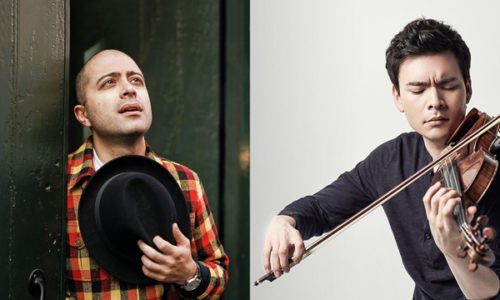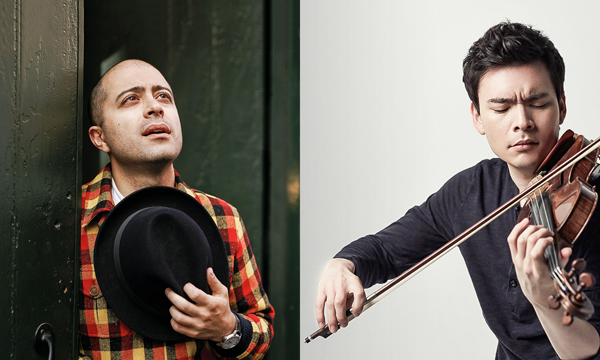 United States J.S. Bach, Viktor Kalabis, C.P.E. Bach, Walter Piston: Stefan Jackiw (violin), Mahan Esfahani (harpsichord). Presented by San Francisco Performances, Herbst Theater, San Francisco. 23.1.2020. (HS)
United States J.S. Bach, Viktor Kalabis, C.P.E. Bach, Walter Piston: Stefan Jackiw (violin), Mahan Esfahani (harpsichord). Presented by San Francisco Performances, Herbst Theater, San Francisco. 23.1.2020. (HS)

J.S. Bach — Sonata No.1 in B minor for Violin and Keyboard
Viktor Kalabis — Sonata for Violin and Harpsichord
C.P.E. Bach — Sonata in B minor for Violin and Harpsichord
Walter Piston —Sonatina for Violin and Harpsichord
After the piano came along in the early 19th century, composers cast it in the leading keyboard role, reassigning the delicate, tinkly timbre of the harpsichord as a sort of character actor. Stravinsky, for example, used the harpsichord in his opera The Rake’s Progress to evoke Mozart’s era within a neoclassical design.
But along the way, especially in the twentieth century, a few composers put their minds toward making the most of the instrument’s quietly distinctive attributes. In a short recital that barely exceeded one hour, harpsichordist Mahan Esfahani and violinist Stefan Jackiw — as part of San Francisco Performances’ PIVOT: New Adventures in the Performing Arts — played works from twentieth-century composers who found their own styles with the harpsichord.
Sonatas for the two instruments by the Czech composer Viktor Kalabis and the American Walter Piston shared the program with those of J.S. and C.P.E. Bach. The results were not only terrifically entertaining but also brought out elements shared by all four composers.
Kalabis, for example, knew his way around the instrument because he married the eminent harpsichordist Zuzana Ruzickova, and according to the program notes the two of them ‘became a powerful force in Czech music’ in the 1960s and 1970s. From 1967, the Sonata for Violin and Harpsichord explores the keyboard’s possibilities in ways that would be familiar to either Bach, but it also wends its way toward the dissonances and sudden shifts more familiar to modern ears.
The piece started out with finely wrought counterpoint between the keyboard and the violin, but quickly veered off into spikier harmonies and even crashing chords. Or rather, as crashing as the quiet instrument could be. And then, a moment of lovely harmonic consonance would emerge, and sort of re-set the game.
The central Andante describes a lyrical expansiveness that we know well from J.S. Bach’s slow movements, and the finale’s resolution — gravelly harmonies and melodic skips leading to a remarkably affecting final cadence — was magical. It helped that both Esfahani and Jackiw played with consummate grace, unanimity, and fluidity, corralling what could be contradictions into making perfect sense.
Kalabis composed this sonata for his harpsichordist wife and the renowned Czech violinist Josef Suk. Piston’s Sonatina for Violin and Harpsichord, which dates from 1945, was written for harpsichordist Ralph Kirkpatrick (who catalogued the keyboard works of Domenico Scarlatti) and Alexander Schrader, long the second violinist for the Budapest String Quartet.
Piston took advantage of the harpsichord’s ability to execute rapid flurries of notes, which Esfahani played with clarity and finesse. Jackiw sailed over the intricate keyboard role with red-white-and-blue march music and, in the gorgeously peaceful central Adagio, expressively long arcs of melody.
J.S. Bach’s Sonata No.1 in B minor for Violin and Harpsichord opened the concert with beautifully wrought playing on a piece that could be heard as the fundamental template for a Baroque sonata or suite. Esfahani and Jackiw exquisitely rendered Bach’s writing in unison one moment, in harmony the next, and elsewhere in counterpoint.
Including a sonata (also in B minor) by C.P.E. Bach (son of J.S.) was a nice stroke, as it introduced some of the ways the Classical era turned away from the Baroque. Less complex but equally generous and vivid, this sonata finds its interest in the interaction between the two instruments as equals — rather than either as a soloist. Esfahani and Jackiw made it all seem totally natural.
Harvey Steiman
